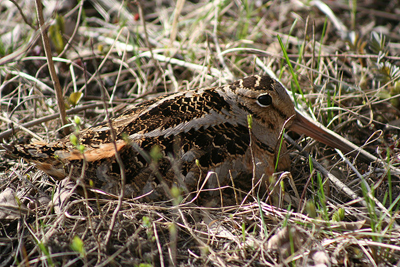
American Woodcock. Photo by Parc-nature de la Pointe-Aux-Prairies, Montreal, Canada.
American Woodcock
(Scolopax minor)
Cool Fact:
American Woodcock have surprising large eyes that are located high and far back on the skull— perfectly positioned to help them watch out for flying predators while they probe the ground for food.
Many Mainers have a particular affinity for a certain grapefruit-shaped bird, and to us, spring hasn’t officially arrived until we’ve heard the “peent” of a woodcock.
American Woodcocks feed on earthworms, beetles, snails, spiders, and other invertebrates they find in the ground. In fact, they are specially designed for probing the soil; they have a long bill with a flexible upper mandible that is perfect of snatching worms. They may shift their weight forward and back and foot to foot, creating vibrations that stimulate earthworms to move, making it easier for the birds to find them. Such specialized feeding strategies are hardly made for the frozen ground, so when the woodcocks, or timberdoodles, as they are sometimes called, return, it’s safe to be fairly optimistic that winter is loosening its grip.
In early spring, woodcock are most likely to seek out patches of bare earth among the snow in fields and clearings, which tend to be near water, where, if their search for insects is a bust, they may feed on plant material. But don’t necessarily expect to see them, at least not easily. Even in their small islands of thawed ground, they are well camouflaged, with their mottled brown, black, and gray plumage blending in perfectly with the muddy earth.
Most often, it’s the male’s breeding display that gives the bird’s presence away—and that lifts the spirits of anyone ready to say goodbye to winter and recognizes the loud, nasally peent calls, given as night approaches. The males also put on a mesmerizing display in the darkening sky, hundreds of feet in the air. Although difficult to see, the display starts with the male rising into the air on whistling wings until it reaches its zenith, where it begins a series of wide, descending circles, all the while uttering a persistent high-pitched twittering vocalization that can be heard from a surprising distance. As the bird descends, the circles get smaller and the twittering gets faster until suddenly, at 50 to 100 feet above the ground, the bird goes silent and swoops down to land. A few seconds later the loud, nasal peent calls start up again. And so it goes until darkness fully descends.
It’s hard to imagine such a mild mannered-looking bird going to such an extreme to attract a mate. On the ground, it appears as a small, plump shorebird, with short legs and neck. Unlike its coastal shorebird cousins, which tend to dart about in quick movements, the woodcock pokes about slowly so it can tune in to the forest floor for food. If you’re fortunate, you’ll catch a glimpse just before you startle one into flight if you happen to be strolling in a shrubby field or young forest, where they breed. More likely, what you’ll see is what birders fondly describe as a “flying grapefruit” as the startled bird flees.
The American Woodcock winters in the southern U.S. (where some spend the entire year) and breeds throughout eastern states and provinces north into southern Canada. The females create an open, shallow depression in the leaf litter, where she lays 1-5 eggs, once per breeding season.
Although the American Woodcock is not a species of high conservation concern based on bird surveys, it can be a challenging bird to detect based on traditional survey methods. Their populations appear to be in slight decline, particularly here in New England, in Minnesota, and areas of the Mid-Atlantic, and is included in the 2014 State of the Birds Watch List that highlights birds most endanger of becoming extinct unless conservation action is taken. Although they are one of just a few species of shorebirds that continue to be hunted, larger threats are loss of habitat to natural forest succession and increased land development. The best way to ensure the longevity of American Woodcock population is through protection of appropriate habitat.
Allison Childs Wells is NRCM’s senior director of public affairs. Formerly communications director for the Cornell Lab of Ornithology, she is a lifelong birder, and along with her husband Jeff, writes a birding column for the Boothbay Register and is coauthor of the book Maine’s Favorite Birds.










